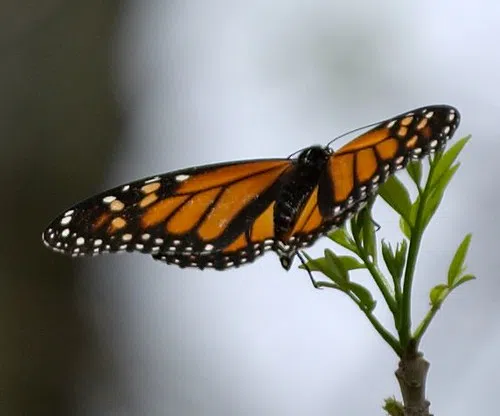While colder weather is approaching and pollinators like the monarch butterfly aren’t top of mind, there are still things we can do to even at this time of year protect the species at risk.
World Wildlife Fund Canada’s resident botanist, Ryan Godfrey says new research is showing how climate change is impacting monarchs’ navigation and biological cues that allow them to successfully migrate and survive winter.
Godfrey says the monarch’s 5000 km trek to winter in Central Mexico and flight back to Canada and the U.S. in the spring is truly one of nature’s greatest wonders.
“That one generation goes all the way from Canada down to Michoacán. They overwinter there and then the following year it takes them four or more generations to make it back up north. So when they wake up in the spring, the first generation will only make it about as far as about northern Mexico and then they will reproduce, lay their eggs on milkweed plants, hatch, grow into caterpillars, metamorphose into butterflies. And then the next generation makes it a little bit further into sort of southern United States.They do that whole thing over again. The next generation makes it a little bit further. So four generations or so to make it up to us. And then one generation flies all the way back down. And they’ve never been to Mexico – it’s crazy to think about that.”
While population numbers fluctuate year-to-year naturally with cyclical population, in general, populations continue to decline rapidly.
In 1996 monarchs covered 18.19 hectares at their overwintering habitat.
In 2024 they covered less than 1 hectare.
Godfrey says climate change is very relevant to their journey.
“Recent studies are showing that monarch butterflies use a bunch of different cues in their migration path. So they’re using, believe it or not, magnetic fields are part of it. They use the sun to help orient themselves. But also temperature is an important part of it. So if you expose monarch butterflies to they change their direction of their travel.”
Other major threats to the monarch include the loss of their Mexico habitat but also loss of food plants and habitat along their migration routes.
Godfrey says milkweed is extremely important to the monarch’s survival – it is the only plant they lay their eggs on as that’s the only plant the caterpillars eat.
For adult monarchs nectar is crucial to their survival.
While flowering plants are in abundance during the summer, Godfrey says fall plants are an important food source during their migration.
He suggests planting milkweed and other native plants that continue to bloom well into the fall.
“Asters and goldenrods are the best options really. And they’re beautiful plants, great to grow in gardens. And there’s dozens of different species of aster and goldenrods too.”
Godfrey also says fall is great time to plant things that will grow next spring.
“A lot of people think that you gotta plant and do your seed in the spring but actually for native plants, not true. You can plant anytime before the frost is a great time to toss your seeds down on the ground. They will overwinter and freeze. That’s a natural part of their life cycle and they actually need that in order to germinate in the spring. So now is kind of the perfect time to get seeds down.”
WWF’s online regrow program offers plenty of tips on growing native plants and taking action in favour of biodiversity.
Godfrey says there is an option to register and add your garden to a map.
“You will see on the map whether there are maybe people nearby who are taking actions to so if you’re interested in growing a native plant garden it might be fun for you to connect with some other people nearby who are also doing the same thing. You know maybe you can swap seeds or share plants or even just share tips or photos or observations you’ve been making.”
Learn more at www.wwf.ca/regrow









Comments